Explore the latest news and find out what's on this month
Explore our learning offer for schools, families and community groups
Uncover the rich history of Elmbridge with our latest online exhibitions
Want to discover more about your local area?
Explore the latest news and find out what's on this month
Explore our learning offer for schools, families and community groups
Uncover the rich history of Elmbridge with our latest online exhibitions
Want to discover more about your local area?

Carlie at the Civic Centre
Hi fellow readers! My name is Carlie and I am a year 10 student studying GCSE History, French, Drama and Food Preparation and Nutrition at St. Philomena’s Catholic High School for Girls. I worked at Elmbridge Museum from 27 February to 2 March 2023 for my work experience. I spent my placement week with the museum team and some volunteers who were all passionate about history.
I wanted to work at a museum as I was quite keen on history and learning about different stories from the past often intrigues me. I wanted to spend my placement week gaining experience in an area that would interest me and thought working at a museum would help me understand some of the career options related to history. Elmbridge Museum was one of the nearest museums to my home (which is still a bit of a trek unfortunately) that looked like a nice place to work, and also fits my school’s requirement for work experience.
My experience throughout the week was pleasant. Members of the museum team, Ellie, Amy, Sue and Jodie had been very kind and generous to provide me with lots of information and talk me through their work in detail to help me gain a deeper understanding of their jobs. I got to visit one of the collection stores and an exhibition, which gave me an insight into how the team operates and the end products of some of the team’s projects. I helped with some of the work and found myself completely focused on it. This allowed me to see what sort of work I enjoy more or am better at. Working in a new environment also pushed me to do my best and prioritise growth. The experience at Elmbridge Museum was all-rounded and surely is helpful for my future career as well as my personal development.
The day before and on the morning of the first day of work, I was a bit anxious about the work, and even more, about the impression I would leave. I was afraid that the work would be too challenging for me or that I couldn’t display an appropriate attitude toward it. I arrived 20 minutes early in case anything happened that morning. I wasn’t entirely overwhelmed by my fears though. Part of me was excited about the work as it was a rare opportunity to work in a museum as a student. Also, I had already read through all the documents that Ellie (Museum Manager), who was my work experience supervisor, emailed me beforehand more than 3 times, just so that I didn’t misunderstand or miss anything about the work. Thankfully, the documents were detailed and clear enough to get me mentally prepared.
To start, Ellie walked me through the fancy building of the council and gave me an introduction to the history of the museum and the work of the local council along the way. I listened very carefully so I could grasp every detail and I asked questions in case I missed anything and because I wouldn’t normally get to learn about these things at school. Ellie always made sure I understood everything. She provided me with lots of resources so I could gain a deeper understanding of the museum as well as local histories. As we went by the Drawing Esher display case, Ellie told me that was the museum’s largest display. I felt a bit of shock, disbelief and a sense of “That’s it?” I later understood what an outreach museum — like Elmbridge Museum — is: its objects are exhibited in various venues and ways instead of one big centralised exhibition. There was a lot more on display than this one exhibition and I got to visit one of the other exhibitions the following day.
 Carlie and museum staff looking at Drawing Esher exhibition at the Civic Centre
Carlie and museum staff looking at Drawing Esher exhibition at the Civic Centre After a nice quiet lunch break at the canteen, Ellie drove me to one of the collection stores. During the drive, we chatted a bit about everything, mostly about our school lives and visiting museums. I reckon that talking is an important skill to develop in the workplace, just as any other employability skill is.
The collections store was a chilly room filled with boxes of all sizes on shelves and cabinets. We opened some of the objects that I was interested in and observed them. There were costumes and drawings and posters from the past and a lot of other kinds of things that I didn’t get to see. For every object we saw, Ellie would tell me a bit about its history and how the museum looks after it. I was most absorbed by a worn-out auctioneer’s catalogue of Oatlands Estate sale particulars. The language used on the printing made me curious about how people in the 19th century spoke and the pencil markings kept me wondering what the person who wrote them was making a note about. At the end of the day, I feel that this part of the history subject did spark me in some way.
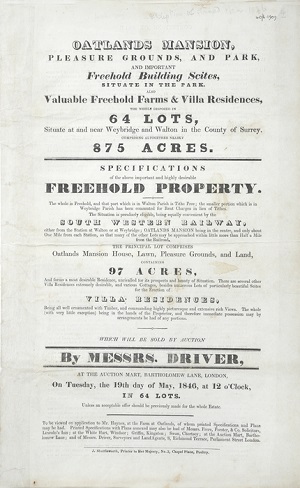 40.1909/b Oatlands Estate sale particulars
40.1909/b Oatlands Estate sale particulars 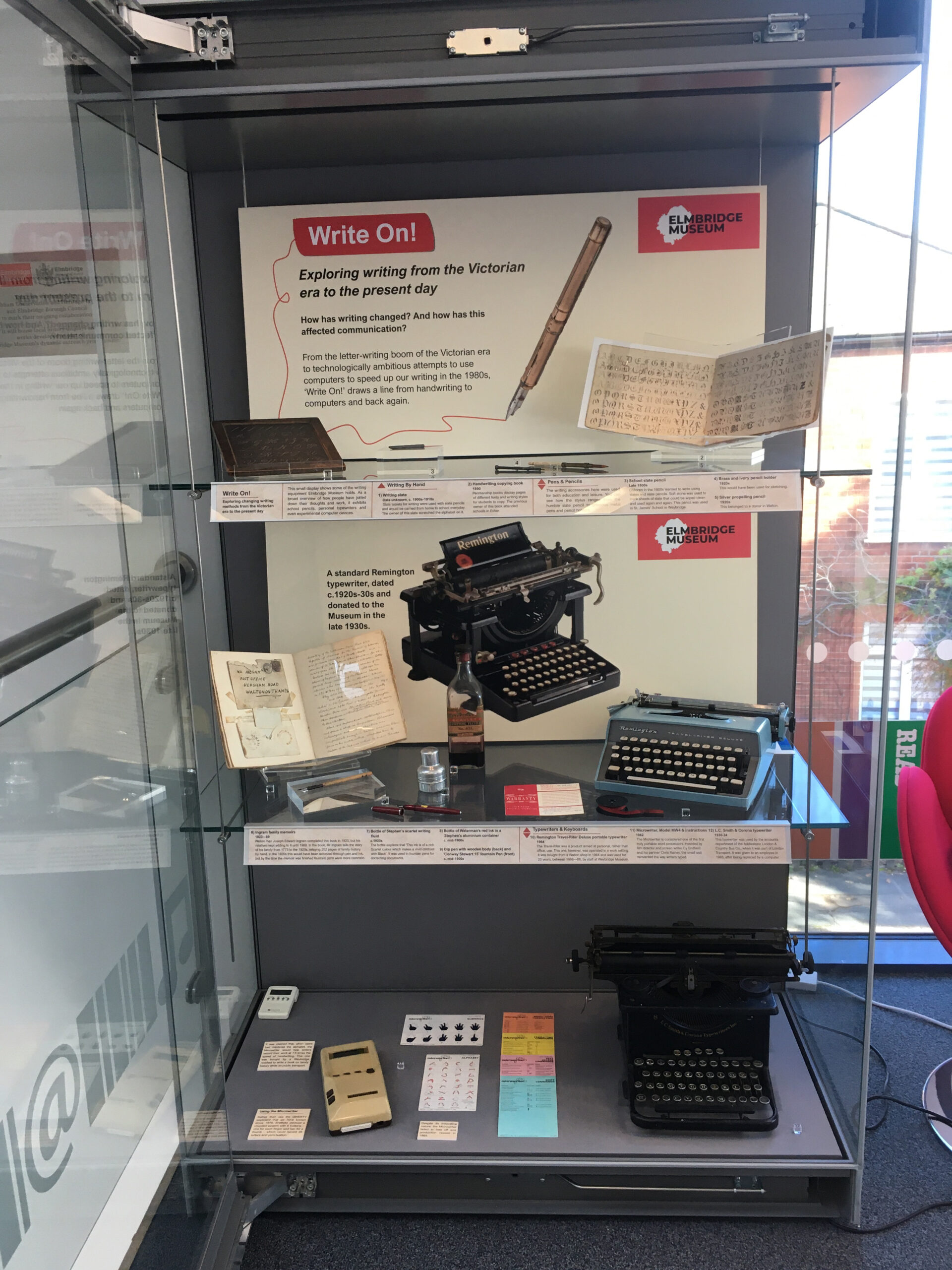 Write On! exhibition at Cobham Library
Write On! exhibition at Cobham Library
On the morning of the second day, Amy (Exhibitions and Interpretation Officer) thoroughly went through her area of work, which included, but is not limited to, the exhibition part of the museum work. Like the day before, it was a lot of talking but I listened as attentively as I could, which indicated that I was interested. I learnt about the different forms of exhibitions, how events are scheduled, things to consider when choosing an exhibition theme, how she collaborates with different organisations or individuals and challenges she faced when reaching out to audiences. She also gave me some handouts on the project schedule and the procedures for working on projects. This part of the work involves planning and interpretation skills and reaching out to communities. She drove me to one of the exhibitions at the Cobham library, called Write On! and talked about the components in a display case. The exhibitions were accessible and informative to the general public. These are the ones you would see in community venues like libraries and churches, and stop by for a second to look at. Usually, I don’t pay much attention to these exhibitions. But now that I’ve given the descriptive text a bit of a read, I find it interesting as it gives you an idea of the local history, and I’d stop by longer. This part of the work experience gave me an insight into the work involved in an exhibition and what an exhibition could look like.
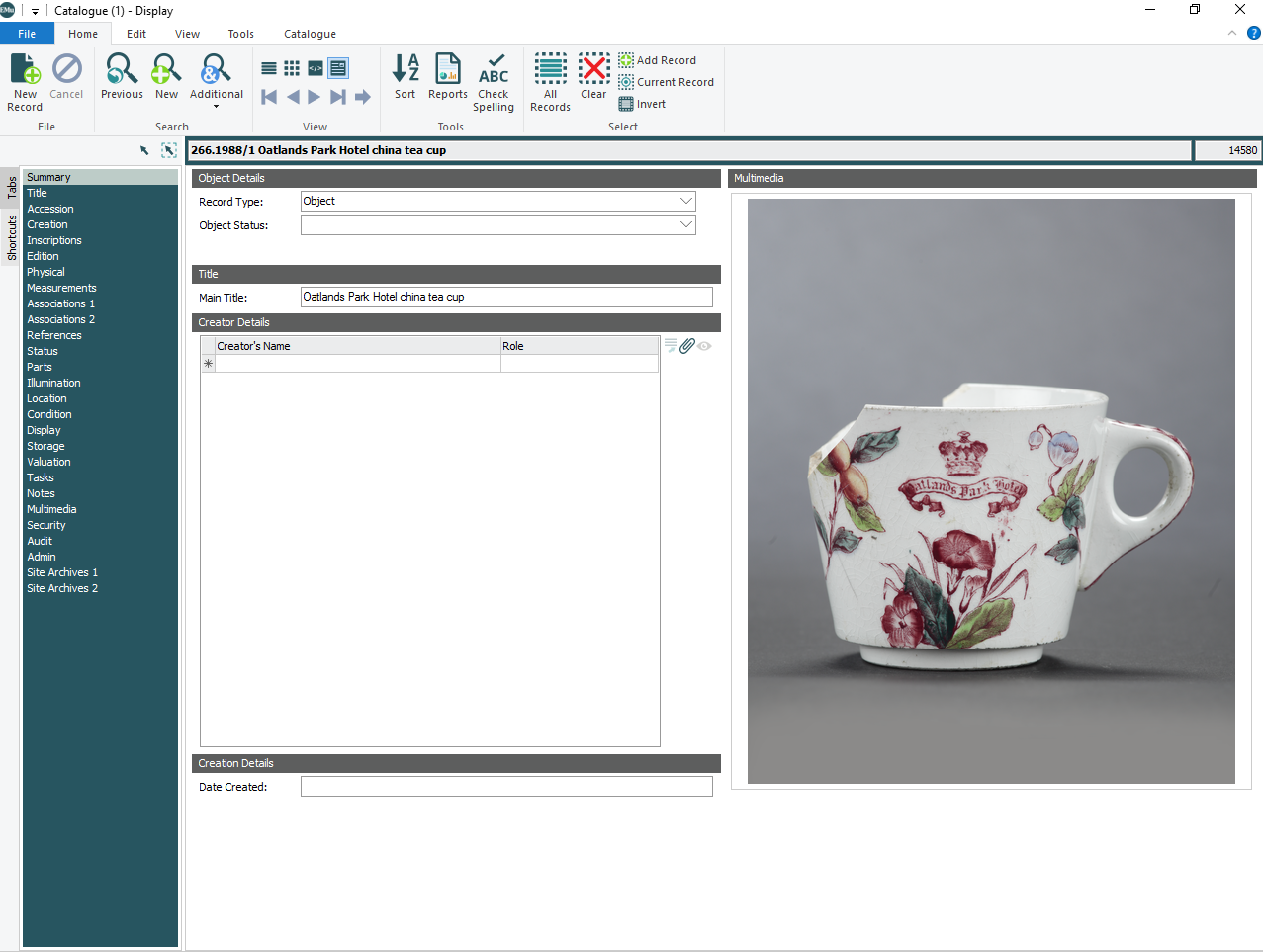 Database record for Oatlands Park Hotel china tea cup which I researched during my work experience
Database record for Oatlands Park Hotel china tea cup which I researched during my work experience
In the afternoon, Sue (Collections Officer) showed me the EMu database, which stored the information of the 43,000 objects in the museum. She showed me how data is categorised and stored. She pointed out the flaws in the record-keeping system and human errors in the process of recording data itself. I suppose this is what it’s like to be working tight on resources — you’ve got to compromise on your work priorities. She then talked about the conservation part of her work. She talked about details on how you should handle different kinds of objects, the difficulties of conserving them and how she supported the work of the others in the team like making sure objects are in good condition for Amy so she could show them to the public. Although I know that it is impossible to get adequate training on conservation work within a day, it’s a shame that I couldn’t go about the conservation work after listening to all the fun details.
On the third day, I got to work with volunteer Marilyn to answer enquiries from the public. We were working to find information about motor racing driver Patsy Burt by searching the museum’s Local Studies resources. I learnt how the museum organised its files and stuff and therefore how to locate the ones I needed. I also learnt how to narrow down the resources I needed to look into, by choosing the resources that I might need and filtering out irrelevant information, which required some critical thinking. The process was an engaging one, as we had always been in hope and didn’t want to let go of any chance of finding something. After 2 or 3 hours of searching files, books and websites, we eventually couldn’t find anything about her. I enjoyed the process nevertheless and am sure that I would love to do this in the future again.
After that, Jodie (Learning and Outreach Officer) talked about the learning programmes she had organised for the general public to engage in learning history and a historical walk (in Kent Town in East Molesey) she was planning. I got to see the objects in some of the discovery boxes while helping her check them to make sure none of the objects were missing or broken, and I thought that the boxes were a really good idea to help children get in touch with a particular time in history. I have to admit, I was a bit slow in checking the objects, but it was because they were intriguing to me that I wanted to look at them one by one in detail.
To end the day, I talked to another volunteer, Anthony, about everything he knew about the history of Molesey and about the new historical walk he was planning. Jodie suggested that I help research the history of Molesey to help with preparations for the walk.
Continuing from day 3, I started researching the history of boating in Molesey, including the Molesey Boat Club, Molesey roller and Molesey Lock. It took me 2 hours to research just about 3 pages of relevant information. I love doing this sort of research and it doesn’t bore me.
I discovered that Molesey Boat Club was founded in April 1866 and the present clubhouse opened in 1901 as a memorial to James Milner who was a key early figure as honorary secretary to the regatta for over 10 years.
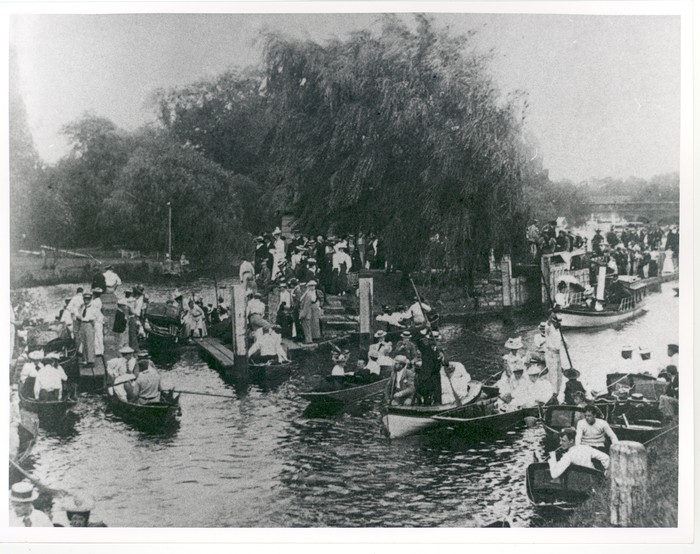 Photograph of Molesey Lock with boats in the lock and rowing boats going over the rollers
Photograph of Molesey Lock with boats in the lock and rowing boats going over the rollers I also learnt about Molesey Lock which opened in 1815 and was reconstructed in 1906. A proposal had to be submitted to Parliament to get approval to construct the lock.
Elmbridge Museum has 23 images of Molesey Lock in the collection at different points in its history which I was able to search for and browse on the collections database. I selected some images for Anthony to use on his historical walks which show the development of the lock and will give people an idea of how the area has changed.
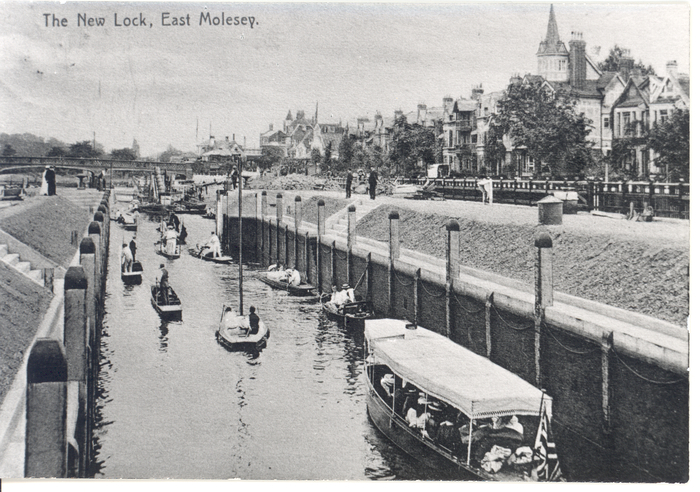 Copy of a postcard of ''The New Lock, East Molesey", showing several punts, boats and a pleasure boat in the Lock
Copy of a postcard of ''The New Lock, East Molesey", showing several punts, boats and a pleasure boat in the Lock 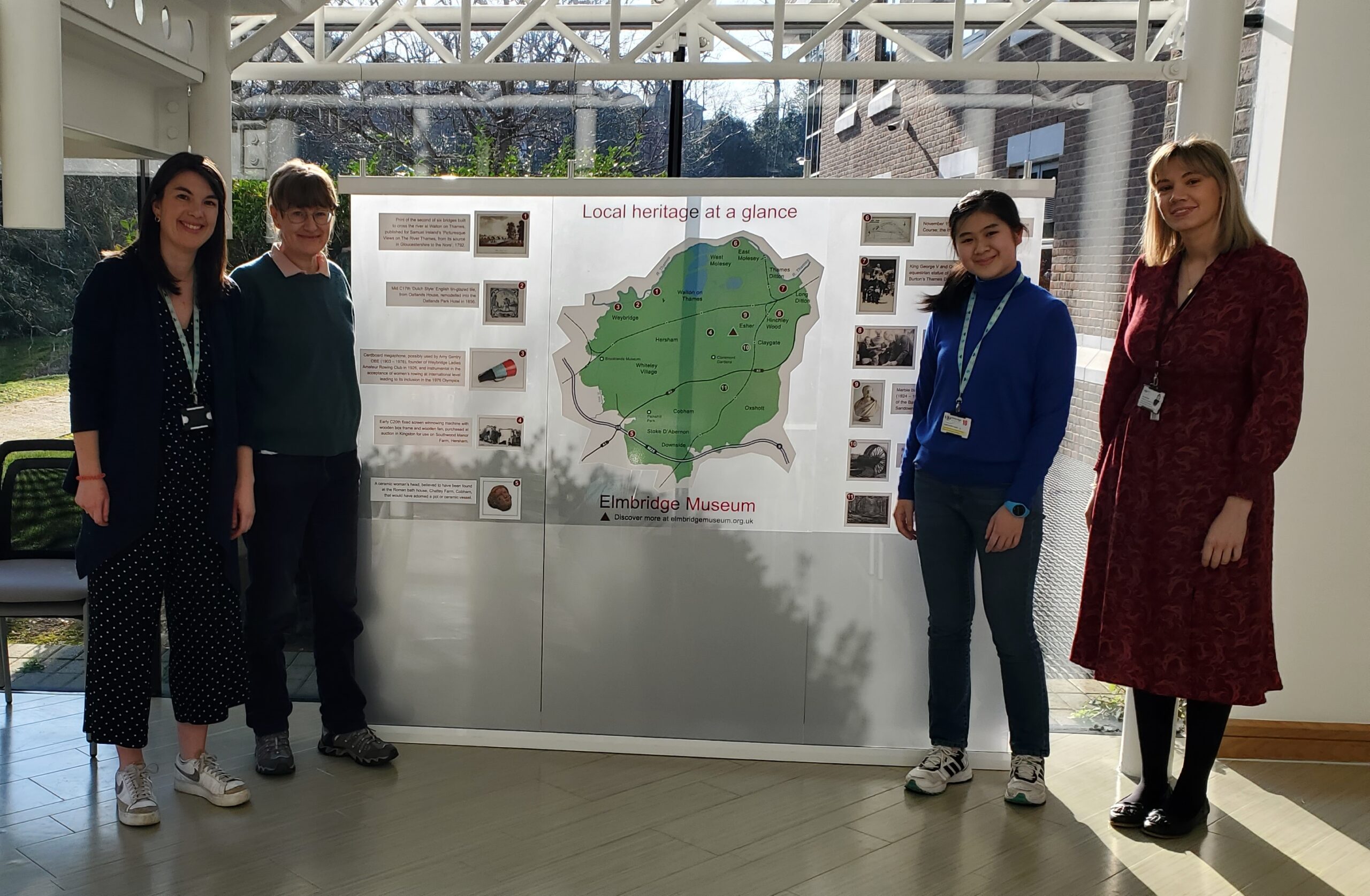 Carlie with Ellie, Sue and Amy
Carlie with Ellie, Sue and Amy
At last, the museum team took me to a cafe nearby for a leaving tea. Ellie treated me to hot chocolate and muffin, which I thought was very nice of her. We had a great chat which ended the work experience nicely.
On these few work days, I found myself making the most out of my lunch and break time. I barely touched my phone and concentrated on reading in my free time. When I ate, I took my time to enjoy my food, trying to put my mind off work. I had learnt to quickly adjust my mood between work and break time to make the most out of my time.
Working with the team was great. They had been very caring and our interaction had been comfortable throughout. If Ellie had noticed me caught up in any topic, she would surely help me learn more about it. The team made sure to involve me in our chats from time to time.